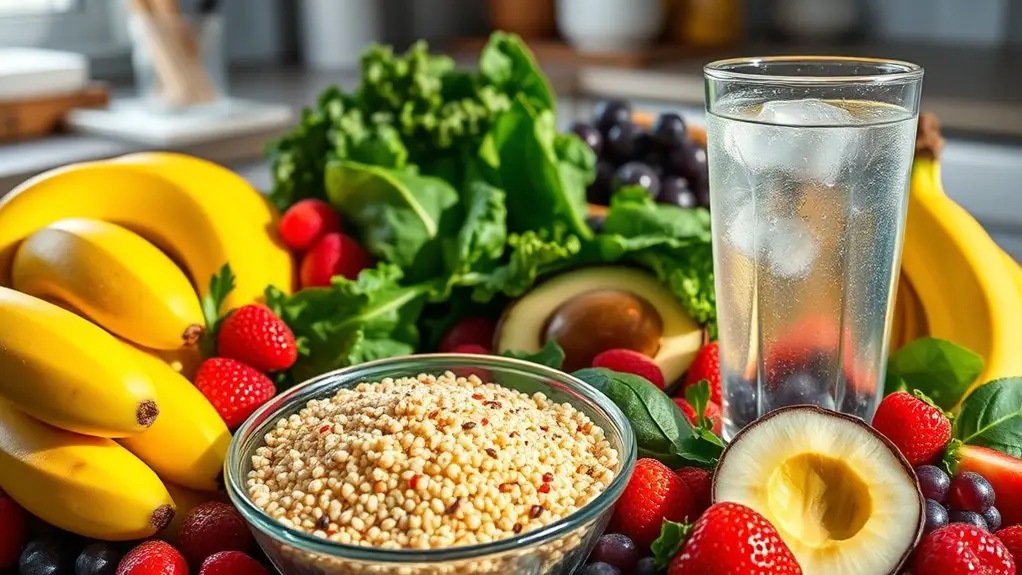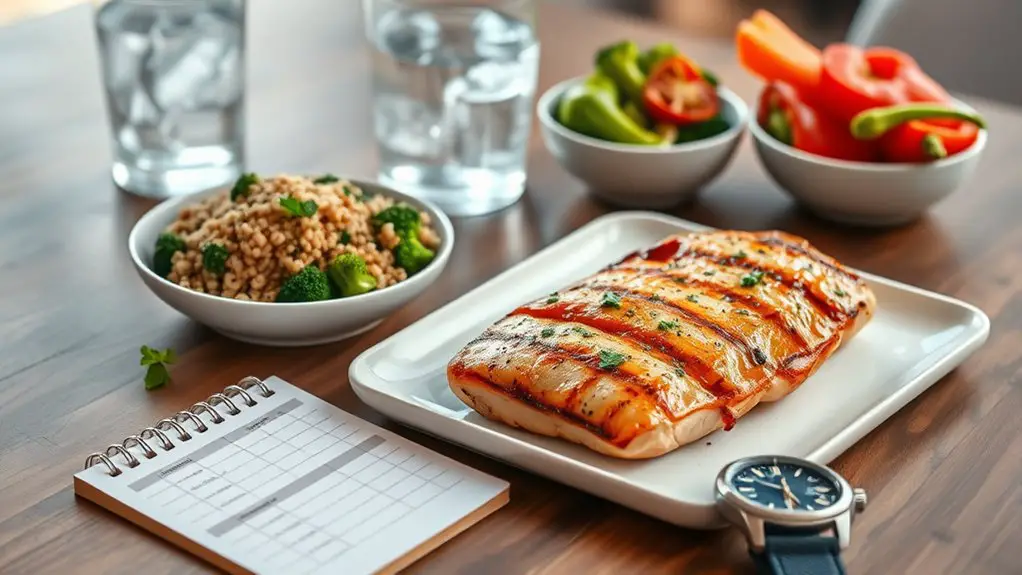To avoid muscle loss during weight cuts, prioritize muscle preservation through effective nutrition and training. Aim for 1.6 to 2.2 grams of protein per kilogram of body weight each day, and space your intake throughout meals. Incorporate strength training at least three times a week, focusing on heavy and moderate lifting. Manage a moderate caloric deficit while staying hydrated and replenishing electrolytes to support your performance. There are more strategies to help you optimize your results.
Understand the Importance of Muscle Preservation
When you're cutting weight, it's crucial to prioritize muscle preservation, since losing muscle can slow down your metabolism and hinder your performance. You want to feel strong and free, not drained and sluggish. Understanding the importance of maintaining your muscle mass means you can enjoy the benefits of a lean physique without sacrificing your strength. Muscle not only supports your metabolism but also enhances your athletic abilities, giving you the freedom to perform at your best. Instead of focusing solely on the scale, think about how your body feels and functions. By valuing muscle preservation, you're setting yourself up for success, allowing you to enjoy the journey of cutting weight while maintaining the strength and freedom you cherish.
Optimize Your Protein Intake
To maintain muscle mass during a weight cut, optimizing your protein intake is essential. You should aim for around 1.6 to 2.2 grams of protein per kilogram of body weight daily. This'll help protect your muscles from breaking down while you lose fat. Focus on high-quality protein sources like lean meats, fish, eggs, and plant-based options. Don't forget to space your protein intake throughout the day; having it in every meal can maximize muscle synthesis. Additionally, consider incorporating protein shakes or bars for convenience, but whole foods should be your priority. Remember, every meal's an opportunity to nourish your body, so make those choices count. Enjoy the freedom of feeling strong and energized, even while cutting weight!
Incorporate Strength Training
Incorporating strength training into your routine is vital for preserving muscle mass during a weight cut. Lifting weights or using resistance bands helps maintain your muscle fibers, ensuring they don't waste away as you lose weight. Focus on compound movements like squats, deadlifts, and bench presses, which engage multiple muscle groups and boost your metabolism. Aim for a mix of heavy and moderate lifting, and don't shy away from challenging yourself. It's also important to maintain your workout frequency; try to train at least three times a week. This commitment not only fosters strength but also empowers you to feel in control of your body during the cutting process. Embrace this freedom to build a resilient physique while shedding excess weight.
Manage Your Caloric Deficit Wisely
Building strength through resistance training is just one piece of the puzzle; managing your caloric deficit wisely plays a significant role in preserving muscle during weight cuts. Aim for a moderate deficit, around 10-20% below your maintenance calories. Going too low can trigger your body to burn muscle for energy, which you definitely want to avoid. Focus on nutrient-dense foods that fuel your workouts and keep you feeling satisfied. Prioritize protein to support muscle repair and growth, and don't forget healthy fats and carbs for energy. Listen to your body, and adjust your intake based on how you're feeling and performing. By striking the right balance, you'll empower yourself to cut weight while keeping your hard-earned muscle intact.
Stay Hydrated and Maintain Electrolyte Balance
Staying hydrated is essential, especially when you're cutting weight, as even mild dehydration can hinder your performance and recovery. Make it a priority to drink water throughout the day, not just during workouts. Electrolytes, like sodium, potassium, and magnesium, are equally important. They help regulate fluid balance and muscle function. When you sweat, you lose these crucial minerals, so replenishing them is key to maintaining energy levels and preventing muscle cramps. Consider adding electrolyte-rich foods or supplements to your routine. Listen to your body—if you're feeling sluggish or cramping, it's a sign you need more hydration. By keeping your fluids and electrolytes in check, you'll support your weight cut while preserving your hard-earned muscle.
Monitor Your Progress and Adjust Accordingly
Keeping an eye on your progress is essential during a weight cut to confirm you're not sacrificing muscle mass. By tracking your changes, you can tweak your approach as needed. Here are four key areas to monitor:
- Body Weight: Weigh yourself regularly to spot trends, not just day-to-day fluctuations.
- Body Measurements: Measure your waist, hips, and limbs to assess fat loss versus muscle retention.
- Strength Levels: Keep track of your performance in the gym to confirm you're maintaining strength.
- Energy Levels: Pay attention to how you feel; fatigue can indicate you're losing more than just fat.
Adjust your diet and training based on these insights to stay strong and free during your weight cut journey.
Frequently Asked Questions
How Can I Tell if I'm Losing Muscle During a Weight Cut?
You can tell if you're losing muscle by monitoring your strength, noticing changes in body composition, and tracking your workout performance. If you're feeling weaker or your physique looks different, muscle loss might be occurring.
Is Intermittent Fasting Effective for Preserving Muscle While Cutting Weight?
Intermittent fasting can be effective for preserving muscle while cutting weight, but it's essential you maintain adequate protein intake and strength training. It's all about balance, so listen to your body and adjust accordingly.
What Role Do Supplements Play in Muscle Preservation During Weight Cuts?
Imagine a knight fortified with elixirs during battle; similarly, supplements can help you maintain muscle while cutting. They provide essential nutrients, support recovery, and help you stay strong, giving you the freedom to reach your goals.
Can I Still Do Cardio While Trying to Maintain Muscle?
Absolutely, you can still do cardio while trying to maintain muscle! Just focus on moderate intensity and balance your workouts with strength training. Listen to your body, and make certain you're fueling it properly for recovery.
How Often Should I Adjust My Caloric Intake During a Weight Cut?
When cutting, you should adjust your caloric intake every couple of weeks based on progress. For instance, if you're losing weight too quickly, consider increasing calories slightly to maintain energy and muscle.




